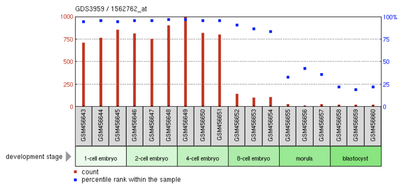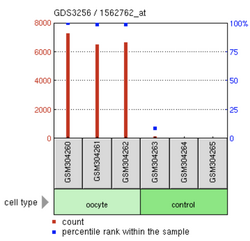Biology:C3orf56
C3orf56 is a protein encoding gene found on chromosome 3. Although, the structure and function of the protein is not well understood, it is known that the C3orf56 protein is exclusively expressed in metaphase II of oocytes and degrades as the oocyte develops towards the blastocyst stage. Degradation of the C3orf56 protein suggests that this gene plays a role in the progression from maternal to embryonic genome and in embryonic genome activation.[1]
Gene
The C3orf56 gene is positioned at 3q21.3 on the plus strand and is 5,055 base pairs in length.[2] The gene occupies base pair 127193131 to 127198185.[3] C3orf56 has two aliases: FLJ40141 and LOC285311.[4]
Transcript
The primary assembly contains 2 exons and is 242 amino acids in length.[5]
Protein
C3orf56 has a predicted molecular weight of 26 kdal[6] and an isoelectric point of 8.48.[7]
Primary Structure
C3orf56 is rich in proline, serine, and tryptophan.[8] It has one highly conserved internal repeat which spans from G85 to P125 and G146 to P178.[9]
Secondary Structure
Only one highly conserved alpha helical structure was predicted.[10][11]
Tertiary Structure
The tertiary structure of C3orf56 was predicted with a confidence score of -3.08.[12] It is suggested to possess many hydrogen bonds and salt bridges.[13]
Protein-Protein Interactions
C3orf56 has been predicted to interact with tyrosine-protein kinase transmembrane receptor (ROR2)[14] and oocyte-expressed protein homolog (OOEP).[15]
Gene level regulation
Expression
C3orf56 has shown to be over-expressed in the testes.[16] Relative to the expression of all other genes, C3orf56 has shown an almost absence of expression in human tissues (excluding the ovary) than in metaphase II oocytes.[17] C3orf56 also has an expression relatively lower in the 8-cell embryo stage and significantly lower in the morula and blastocyst stages compared to the 1-cell, 2-cell, and 4-cell stages.[18]
RNA binding proteins and transcription factors
RNA binding proteins seem to be conserved within the 5’ UTR and show some functional significance with sex and development.[19] Many predicted transcription factors also demonstrated a functional importance in development.[20]
Transcript level regulation
Predicted stem loops
Hypothetical stem loops appear to be slightly more prevalent in the 3’ UTR sequence with more conservation of stem loops in the 5’ UTR sequence.[21]
Protein level regulation
Post-translational modifications
C3orf56 has many predicted post-translational modifications. Predicted protein kinase C phosphorylation sites were found at and S6-K8, K181-C183, and S228-R230.[22] Predicted casein kinase II phosphorylation sites at S109-S112, S213-E186, and S218-L220.[23] General phosphorylation sites were predicted at T3, S6, S21, S109, T160, and S227.[24] N-myristoylation sites were predicted to be found at G2-E7, G26-S31, G38-S43, and G146-S151.[25]
Localization
A potential nuclear localization signal was found at position P231 to R238 along with a suggested nuclear tendency.[26]
Evolutionary History
The earliest appearance of the C3orf56 gene was approximately 102 million years ago within the species Orycteropus afer. Compared to the speed at which the proteins fibrinogen alpha and cytochrome c evolved, C3orf56 evolves very rapidly. This relationship was limited to more recently diverged species.
Homology
C3orf56 has numerous orthologs that are only within various placental mammals.[27] No known paralogs of C3orf56 exist at this time.
| Genus and Species | Common Name | Taxonmic Order | Date of Divergence (MYA) | Accession Number | Sequence Length (aa) | % Sequence Identity | % Sequence Similarity |
|---|---|---|---|---|---|---|---|
| Homo sapiens | Human | Primate | 0 | NP_001007535.1 | 242 | 100 | 100 |
| Rhinopithecus bieti | Black Snub-nosed Monkey | Primate | 29 | XP_017740448.1 | 248 | 87 | 89 |
| Saimiri boliviensis boliviensis | Bolivian Squirrel Monkey | Primate | 43 | XP_003944171.1 | 249 | 76 | 79 |
| Galeopterus variegatus | Flying Lemur | Dermoptera | 83 | XP_008592749.1 | 222 | 57 | 64 |
| Castor canadensis | Beaver | Rodentia | 89 | XP_020010355.1 | 204 | 50 | 56 |
| Jaculus jaculus | Lesser Egyptian Jerboa | Rodentia | 89 | XP_012805719.1 | 226 | 38 | 49 |
| Heterocephalus glaber | Naked Mole Rat | Rodentia | 89 | XP_012924683.1 | 264 | 38 | 49 |
| Mirounga leonina | Southern Elephant Seal | Carnivora | 94 | XP_034854170.1 | 178 | 57 | 64 |
| Phocoena sinus | Vaquita | Artiodactyla | 94 | XP_032503804.1 | 236 | 57 | 61 |
| Eumetopias jubatus | Northern Sea Lion | Carnivora | 94 | XP_027957377.1 | 195 | 54 | 64 |
| Canis lupus familiaris | Dog | Carnivora | 94 | XP_022263109.1 | 232 | 53 | 60 |
| Ailuropoda melanoleuca | Panda | Carnivora | 94 | XP_011228030.2 | 175 | 52 | 58 |
| Equus caballus | Horse | Perissodactyla | 94 | XP_014584106.2 | 240 | 49 | 58 |
| Sus scrofa | Wild Boar | Cetartiodactyla | 94 | XP_020926903.1 | 231 | 49 | 56 |
| Vicugna pacos | Alpaca | Artiodactyla | 94 | XP_031532218.1 | 366 | 49 | 56 |
| Camelus dromedarius | Arabian Camel | Artiodactyla | 94 | XP_031325652.1 | 233 | 45 | 53 |
| Enhydra lutris kenyoni | Sea Otter | Carnivora | 94 | XP_022377075.1 | 247 | 43 | 50 |
| Crocuta crocuta | Hyena | Carnivora | 94 | KAF0873334.1 | 216 | 39 | 46 |
| Bison bison bison | Bison | Artiodactyla | 94 | XP_010857995.1 | 273 | 34 | 21 |
| Monodon monoceros | Narwahl | Cetacea | 94 | TKC45752.1 | 265 | 33 | 43 |
| Orycteropus afer | Aardvark | Tubulidentata | 102 | XP_007951414.1 | 113 | 45 | 54 |
References
- ↑ Bouckenheimer J, Fauque P, Lecellier CH, Bruno C, Commes T, Lemaître JM, De Vos J, Assou S. Differential long non-coding RNA expression profiles in human oocytes and cumulus cells. Sci Rep. 2018 Feb 2;8(1):2202. doi: 10.1038/s41598-018-20727-0. PMID 29396444; PMCID: PMC5797088
- ↑ C3orf56 chromosome 3 open reading frame 56 Homo sapiens - Gene - NCBI. (2020, August 22). Retrieved September 30, 2020, from https://www.ncbi.nlm.nih.gov/gene/285311
- ↑ Database, G. (n.d.). C3orf56 Gene (Protein Coding). Retrieved September 30, 2020, from https://www.genecards.org/cgi-bin/carddisp.pl?gene=C3orf56
- ↑ "C3orf56 Gene - GeneCards | CC056 Protein | CC056 Antibody". https://www.genecards.org/cgi-bin/carddisp.pl?gene=C3orf56&keywords=c3orf56.
- ↑ C3orf56 chromosome 3 open reading frame 56 [Homo sapiens (human)] - Gene - NCBI. (2020, August 22). Retrieved September 30, 2020, from https://www.ncbi.nlm.nih.gov/gene/285311
- ↑ "SAPS < Sequence Statistics < EMBL-EBI". https://www.ebi.ac.uk/Tools/seqstats/saps/.
- ↑ "ExPASy - Compute pI/Mw tool". https://web.expasy.org/compute_pi/.
- ↑ "SAPS < Sequence Statistics < EMBL-EBI". https://www.ebi.ac.uk/Tools/seqstats/saps/.
- ↑ "Dotlet JS". https://dotlet.vital-it.ch/.
- ↑ "NPS@ : GOR4 secondary structure prediction". https://npsa-prabi.ibcp.fr/cgi-bin/npsa_automat.pl?page=/NPSA/npsa_gor4.html.
- ↑ Prof. T. Ashok Kumar. "CFSSP: Chou & Fasman Secondary Structure Prediction Server". http://www.biogem.org/tool/chou-fasman/.
- ↑ "I-TASSER results". https://zhanglab.ccmb.med.umich.edu/I-TASSER/output/S581071/.
- ↑ "iCn3D: Web-based 3D Structure Viewer". https://www.ncbi.nlm.nih.gov/Structure/icn3d/full.html.
- ↑ "PSICQUIC View". http://www.ebi.ac.uk/Tools/webservices/psicquic/view/results.xhtml?conversationContext=2.
- ↑ "STRING: functional protein association networks". https://string-db.org/cgi/network?taskId=bpaoQSDdspUn&sessionId=bacIWnfkJ2nn.
- ↑ "C3orf56 chromosome 3 open reading frame 56 [Homo sapiens (human) - Gene - NCBI"]. https://www.ncbi.nlm.nih.gov/gene/285311.
- ↑ "52817401 - GEO Profiles - NCBI". https://www.ncbi.nlm.nih.gov/geoprofiles/52817401.
- ↑ "74223601 - GEO Profiles - NCBI". https://www.ncbi.nlm.nih.gov/geoprofiles/74223601.
- ↑ "RBPDB: The database of RNA-binding specificities". http://rbpdb.ccbr.utoronto.ca/index.php.
- ↑ "Genomatix" (in de-DE). https://www.genomatix.de/.
- ↑ "RNAfold web server". http://rna.tbi.univie.ac.at/cgi-bin/RNAWebSuite/RNAfold.cgi.
- ↑ "Motif Scan" (in en). https://myhits.sib.swiss/cgi-bin/motif_scan.
- ↑ "Motif Scan" (in en). https://myhits.sib.swiss/cgi-bin/motif_scan.
- ↑ "NetPhos 3.1 Server". http://www.cbs.dtu.dk/services/NetPhos/.
- ↑ "Motif Scan" (in en). https://myhits.sib.swiss/cgi-bin/motif_scan.
- ↑ "PSORT II Prediction". https://psort.hgc.jp/form2.html.
- ↑ BLAST: Basic Local Alignment Search Tool. (2020, September 29). Retrieved September 29, 2020, from https://blast.ncbi.nlm.nih.gov/Blast.cgi
 |





